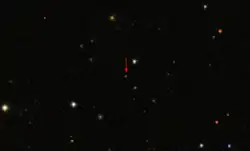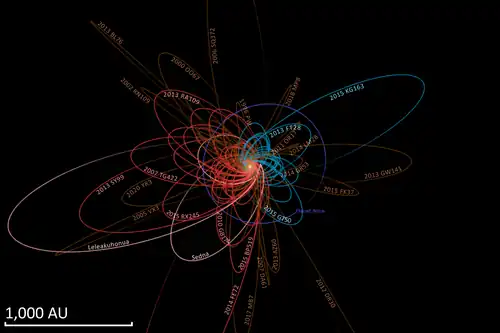2012 DR30
2012 DR30 is a trans-Neptunian object and centaur from the scattered disk and/or inner Oort cloud, located in the outermost region of the Solar System. The object with a highly eccentric orbit of 0.99 was first observed by astronomers with the Spacewatch program at Steward Observatory on 31 March 2009.[2] It measures approximately 188 kilometers (120 miles) in diameter.
 | |
| Discovery[1][2][3] | |
|---|---|
| Discovered by | Spacewatch |
| Discovery site | Kitt Peak Obs. |
| Discovery date | 31 March 2009 (first observed only) |
| Designations | |
| 2012 DR30 | |
| |
| Orbital characteristics[1][lower-alpha 1] | |
| Epoch 27 April 2019 (JD 2458600.5) | |
| Uncertainty parameter 1 | |
| Observation arc | 14.72 yr (5,375 d) |
| Aphelion | 3192 AU 2049 AU (barycentric) |
| Perihelion | 14.5 AU |
| 1603.44 AU 1032 AU (barycentric) | |
| Eccentricity | 0.9909 |
| 64207 yr 33100 yr (barycentric) | |
| 0.0453° | |
| 0° 0m 0s / day | |
| Inclination | 77.986° |
| 341.48° | |
| ≈ 16 March 2011[7] | |
| 195.57° | |
| Jupiter MOID | 9.311 AU |
| Saturn MOID | 5.45 AU[2] |
| Uranus MOID | 3.32 AU[2] |
| TJupiter | 0.9860 |
| Physical characteristics | |
Mean diameter | |
| 19.9[8] | |
| 7.1[1][2] | |
Description
Using an epoch of February 2017, it has the second-largest heliocentric semi-major axis of a minor planet not detected out-gassing like a comet.[9] (2014 FE72 has a larger heliocentric semi-major axis.) 2012 DR30 does have a barycentric semi-major axis of 1032 AU.[10][lower-alpha 1] For the epoch of July 2018 2012 DR30 will have its largest heliocentric semi-major axis of 1644 AU.
| Orbital evolution | ||
| Year[lower-alpha 1] (epoch) | Barycentric Aphelion (Q) (AU) | Orbital period years |
|---|---|---|
| 1950 | 2000 | 32000 |
| 2050 | 2049 | 33100 |
2012 DR30 passed 5.7 AU from Saturn in February 2009 and came to perihelion in March 2011 at a distance of 14.5 AU from the Sun (inside the orbit of Uranus).[1] In 2018, it will move from 18.2 AU to 19.1 AU from the Sun.[8] It comes to opposition in late March. With an absolute magnitude (H) of 7.1,[2] the object has a published diameter of 185 and 188 kilometers, respectively.[5][6]
With an observation arc of 14.7 years,[1] it has a well constrained orbit. It will not be 50 AU from the Sun until 2047. After leaving the planetary region of the Solar System, 2012 DR30 will have a barycentric aphelion of 2049 AU with an orbital period of 33100 years.[lower-alpha 1] In a 10 million year integration of the orbit, the nominal (best-fit) orbit and both 3-sigma clones remain outside 12.2 AU (qmin) from the Sun.[4] Summary of barycentric orbital parameters are:
- Semi-major axis: ~1032 AU[lower-alpha 1]
- aphelion: ~2049 AU[lower-alpha 1]
- period: ~33,100 yr[lower-alpha 1]
Archived data from the JPL SBDB and MPC.[lower-alpha 2][lower-alpha 3]
Comparison

See also
Notes
- Given the orbital eccentricity of this object, different epochs can generate quite different heliocentric unperturbed two-body best-fit solutions to the semi-major axis and orbital period. For objects at such high eccentricity, the Sun's barycenter is more stable than heliocentric coordinates.[11] Using JPL Horizons, the barycentric semi-major axis is approximately 1032 AU.[10]
- Archived JPL Small-Body Database Browser: (2012 DR30) from 15 October 2014.
- Archived MPC object data for 2012 DR30 (2009 FW54) from 12 July 2013.
References
- "JPL Small-Body Database Browser: (2012 DR30)" (2014-12-17 last obs.). Jet Propulsion Laboratory. Retrieved 19 November 2018.
- "2012 DR30". Minor Planet Center. Retrieved 19 November 2018.
- Ernesto Guido; Giovanni Sostero & Nick Howes (27 February 2012). "Trans-Neptunian Object 2012 DR30". Remanzacco Observatory in Italy. Retrieved 25 August 2013.
- Marc W. Buie. "Orbit Fit and Astrometric record for 12DR30". SwRI – Space Science Department. Archived from the original on 5 February 2016. Retrieved 1 February 2016.
- Kiss, Cs.; Szabó, Gy.; Horner, J.; Conn, B. C.; Müller, T. G.; Vilenius, E.; et al. (July 2013). "A portrait of the extreme solar system object 2012 DR30". Astronomy and Astrophysics. 555: 13. arXiv:1304.7112. Bibcode:2013A&A...555A...3K. doi:10.1051/0004-6361/201321147. S2CID 54021504.
- Johnston, Wm. Robert (7 October 2018). "List of Known Trans-Neptunian Objects". Johnston's Archive. Retrieved 19 November 2018.
- JPL Horizons Observer Location: @sun
- "AstDyS 2012DR30 Ephemerides". Department of Mathematics, University of Pisa, Italy. Retrieved 14 February 2017. (Distance to Sun [R] from first day of 2016 to first day of 2020. Assuming average apparent magnitude for 2017.)
- "JPL Small-Body Database Search Engine: Asteroids and a > 100 (AU)". JPL Solar System Dynamics. Retrieved 15 October 2014.
- Horizons output. "Barycentric Osculating Orbital Elements for 2012 DR30". Retrieved 6 March 2014. (Solution using the Solar System Barycenter and barycentric coordinates. Select Ephemeris Type:Elements and Center:@0)
- Kaib, Nathan A.; Becker, Andrew C.; Jones, R. Lynne; Puckett, Andrew W.; Bizyaev, Dmitry; Dilday, Benjamin; et al. (April 2009). "2006 SQ372: A Likely Long-Period Comet from the Inner Oort Cloud". The Astrophysical Journal. 695 (1): 268–275. arXiv:0901.1690. Bibcode:2009ApJ...695..268K. doi:10.1088/0004-637X/695/1/268. S2CID 16987581.
External links
- 2012 DR30 - Ein Transneptun mit ungewöhnlicher Bahn, www.spektrum.de, March 2012 (in German)
- Mysterious solar system object 2012 DR30: period ~50,000 years, inclination 75°, perihelion 14 AU
- Transneptunian Object 2012 DR30 – Is it a comet?
- Images 2012 DR30
- 2012 DR30 Archived 15 January 2020 at the Wayback Machine (Seiichi Yoshida)
- Webcite archive of Epoch 2016-Jan-13 with aphelion (Q) of 2789 AU
- 2012 DR30 at AstDyS-2, Asteroids—Dynamic Site
- 2012 DR30 at the JPL Small-Body Database


